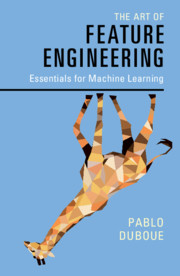Crossref Citations
This Book has been
cited by the following publications. This list is generated based on data provided by Crossref.
Patel, Jayesh
2020.
The Democratization of Machine Learning Features.
p.
136.
Patel, Jayesh
2020.
Unification of Machine Learning Features.
p.
1201.
Lukyanenko, Roman
Storey, Veda C.
and
Pastor, Oscar
2020.
Article 8. Fondements des technologies de l’information d’après la philosophie systémiste de la réalité de Bunge.
Mεtascience,
Vol. N° 2,
Issue. 2,
p.
175.
Sikelis, Konstantinos
Tsekouras, George E.
and
Kotis, Konstantinos
2021.
Ontology-Based Feature Selection: A Survey.
Future Internet,
Vol. 13,
Issue. 6,
p.
158.
Betancourt, Clara
Stomberg, Timo
Roscher, Ribana
Schultz, Martin G.
and
Stadtler, Scarlet
2021.
AQ-Bench: a benchmark dataset for machine learning on global air quality metrics.
Earth System Science Data,
Vol. 13,
Issue. 6,
p.
3013.
Lawler, Robin
Liu, Yao-Hao
Majaya, Nessa
Allam, Omar
Ju, Hyunchul
Kim, Jin Young
and
Jang, Seung Soon
2021.
DFT-Machine Learning Approach for Accurate Prediction of pKa.
The Journal of Physical Chemistry A,
Vol. 125,
Issue. 39,
p.
8712.
Rodríguez-Collado, Alejandro
and
Rueda, Cristina
2021.
Electrophysiological and Transcriptomic Features Reveal a Circular Taxonomy of Cortical Neurons.
Frontiers in Human Neuroscience,
Vol. 15,
Issue. ,
D'Amato, Vincenzo
Oneto, Luca
Camurri, Antonio
and
Anguita, Davide
2021.
Keep it Simple: Handcrafting Feature and Tuning Random Forests and XGBoost to face the Affective Movement Recognition Challenge 2021.
p.
1.
Wang, Xinlei
and
Zhi, Jianing
2021.
A machine learning-based analytical framework for employee turnover prediction.
Journal of Management Analytics,
Vol. 8,
Issue. 3,
p.
351.
Lukyanenko, Roman
Storey, Veda C.
and
Pastor, Oscar
2021.
Foundations of information technology based on Bunge’s systemist philosophy of reality.
Software and Systems Modeling,
Vol. 20,
Issue. 4,
p.
921.
Arias, Victor A.
Vargas-Machuca, Juan
Zegarra, Fabio C.
and
Coronado, Alberto M.
2021.
Convolutional Neural Network Classification for Machine Tool Wear Based on Unsupervised Gaussian Mixture Model.
p.
1.
Casusol, Alexis J.
Zegarra, Fabio C.
Vargas-Machuca, Juan
and
Coronado, Alberto M.
2021.
Optimal window size for the extraction of features for tool wear estimation.
p.
1.
Cabral, J. B.
Lares, M.
Gurovich, S.
Minniti, D.
and
Granitto, P. M.
2021.
Drifting features: Detection and evaluation in the context of automatic RR Lyrae identification in the VVV.
Astronomy & Astrophysics,
Vol. 652,
Issue. ,
p.
A151.
D'Amato, Vincenzo
Oneto, Luca
Camurri, Antonio
and
Anguita, Davide
2022.
The Importance of Multiple Temporal Scales in Motion Recognition: when Shallow Model can Support Deep Multi Scale Models.
p.
01.
Echeverria, Fabricio
Leon, Marcelo
Esteves, Zila
and
Redroban, Carlos
2022.
Informatics and Intelligent Applications.
Vol. 1547,
Issue. ,
p.
3.
Wagner, Gerit
Lukyanenko, Roman
and
Paré, Guy
2022.
Artificial intelligence and the conduct of literature reviews.
Journal of Information Technology,
Vol. 37,
Issue. 2,
p.
209.
Chatzimparmpas, Angelos
Martins, Rafael M.
Kucher, Kostiantyn
and
Kerren, Andreas
2022.
FeatureEnVi: Visual Analytics for Feature Engineering Using Stepwise Selection and Semi-Automatic Extraction Approaches.
IEEE Transactions on Visualization and Computer Graphics,
Vol. 28,
Issue. 4,
p.
1773.
Mangla, Chaitanya
Holden, Sean B.
and
Paulson, Lawrence C.
2022.
Automated Reasoning.
Vol. 13385,
Issue. ,
p.
559.
Demutti, Marco
D'Amato, Vincenzo
Recchiuto, Carmine
Oneto, Luca
and
Sgorbissa, Antonio
2022.
Assessing Emotions in Human-Robot Interaction Based on the Appraisal Theory.
p.
1435.
Jiang, Shiyan
Nocera, Amato
Tatar, Cansu
Yoder, Michael Miller
Chao, Jie
Wiedemann, Kenia
Finzer, William
and
Rosé, Carolyn P.
2022.
An empirical analysis of high school students' practices of modelling with unstructured data.
British Journal of Educational Technology,
Vol. 53,
Issue. 5,
p.
1114.



